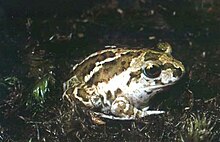Common spadefoot
|
Pelobates fuscus Temporal range: Lower Oligocene–Recent,33.9–0 Ma |
|
|---|---|
 |
|
| Pelobates fuscus fuscus | |
 |
|
| Pelobates fuscus insubricus | |
| Scientific classification | |
| Kingdom: | Animalia |
| Phylum: | Chordata |
| Class: | Amphibia |
| Order: | Anura |
| Suborder: | Mesobatrachia |
| Family: | Pelobatidae |
| Genus: | Pelobates |
| Species: | P. fuscus |
| Binomial name | |
|
Pelobates fuscus (Laurenti, 1768) |
|
| Subspecies | |
|
P. fuscus fuscus |
|
| Synonyms | |
|
|
P. fuscus fuscus
P. fuscus insubricus
Pelobates fuscus is a species of toad in the family Pelobatidae, native to an area extending from Central Europe to Western Asia. It is commonly known as the common spadefoot, garlic toad, the common spadefoot toad and the European common spadefoot.
The common spadefoot grows to a length of approximately 6.5 centimetres (2.6 in) for males and 8 centimetres (3.1 in) for females. The skin colouration varies depending upon habitat, gender and region, but is usually light-grey to beige-brown on the dorsal surface. The skin is mottled by darker marks that differ between individuals. The belly is white, sometimes with grey mottling. Albino specimens have been observed.
Two subspecies are traditionally recognised: Pelobates fuscus fuscus (from central Europe) and Pelobates fuscus insubricus (from Northern Italy). In reality there is no physical or behavioural character allowing to distinguish these supposed subspecies. A recent study showed that there is no haplotype segregation for the populations of Northern Italy, that, therefore, are not to be ascribed to a different subspecies . Haplotypes from some Northern Italian valleys are very characteristic and support a different conception in terms of conservation: not for a different taxonomic position but, instead, for a peculiar differentiation. Populations from eastern Europe appear sufficiently different that they may warrant a separate species status (Pelobates vespertinus).
When alarmed, it emits a very loud call (alarm call) and it can exude a noxious secretion which smells like garlic, hence the common name "garlic toad".
...
Wikipedia

